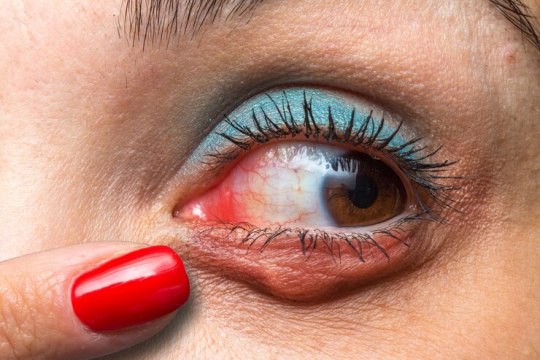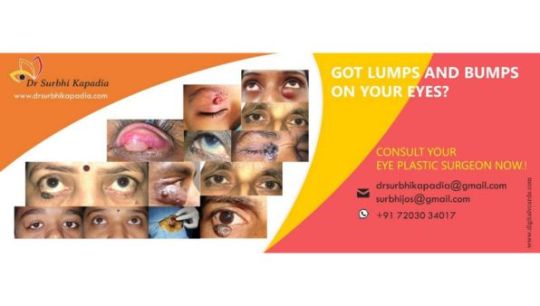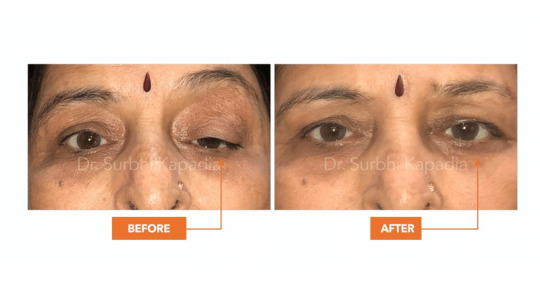#Dr. Surbhi Kapadia
Text
Understanding Dacryocystitis: When to Seek Immediate Medical Attention
Dacryocystitis, an inflammation of the tear ducts, can escalate from chronic discomfort to acute medical emergencies without timely intervention. Dr. Surbhi Kapadia, Vadodara’s esteemed ophthalmologist, explains the critical signs and the importance of early diagnosis in preventing severe complications.

The Gradual and Acute Forms of Dacryocystitis
Dacryocystitis may present in two forms: chronic and acute. Chronic dacryocystitis typically develops due to long-term obstruction of the tear duct, leading to persistent symptoms such as tearing and swelling around the eyes. Acute dacryocystitis, however, is a more severe form, often resulting from a bacterial infection that causes rapid onset of pain, redness, and tenderness around the inner corner of the eye.
Like a clogged drain blocking water flow, blocked tear ducts prevent tears from draining properly, leading to significant discomfort and potential eye damage. Dr. Surbhi Kapadia highlights the importance of recognizing early signs to prevent progression to acute stages, especially in individuals over 40 years in India, where early eye checkups are crucial due to higher susceptibility to eye diseases.
Key Symptoms of Dacryocystitis and When to Consult a Doctor
For anyone experiencing excessive tearing, discharge, or sudden onset of eye pain, consulting an eye specialist is imperative. Dr Surbhi Kapadia advises that symptoms like severe eye pain, noticeable discharge, fever, and vision changes, particularly if they occur suddenly, warrant immediate medical attention. These symptoms could indicate underlying complications like retinal detachment, which require urgent treatment to prevent lasting damage.
Vulnerable Groups and Preventative Measures
Dr. Surbhi Kapadia emphasizes that certain groups, including the elderly, infants, and individuals with nasal conditions or immune-compromising conditions like diabetes, are at higher risk for dacryocystitis. Regular eye examinations are vital for these groups to catch and treat dacryocystitis early, avoiding severe outcomes.
Effective Management of Dacryocystitis
Timely intervention is key in managing dacryocystitis. Depending on the severity, treatments may range from antibiotics to surgical procedures aimed at clearing the blockage and restoring normal tear drainage. Dr. Kapadia recommends maintaining good eyelid hygiene and regular eye check-ups as part of effective eye care routines to prevent the occurrence of dacryocystitis.
For comprehensive eye care and management of dacryocystitis, consult Dr. Surbhi Kapadia at Aadicura Superspeciality Hospital, Vadodara. Her expertise in managing complex eye conditions ensures patients receive the best possible care tailored to their specific needs.
Contact Information for Immediate Consultation
Book your appointment with Dr Surbhi Kapadia today and ensure your eyes are protected against the potential dangers of dacryocystitis. Early detection and treatment are your best defence against this painful condition.
Visit Dr. Surbhi Kapadia’s Website to learn more about preventing and managing eye diseases effectively.
#dacryocystitis#best eye hospital in vadodara#best eye doctor#dr. surbhi kapadia#ophthalmology#eyecare#oculoplasty
0 notes
Text
Act Now: The Importance of Early Retinoblastoma Screening

A simple flash photo could reveal more than you think. If you notice a white disk in your child's eye in flash photography, it may be a sign of retinoblastoma. Dr. Surbhi Kapadia from the Department of Ophthalmology & Ophthalmic Plastic Surgery urges parents to get their children screened today. Early detection can make all the difference in your child's eye health and overall well-being.
#Retinoblastoma awareness#Child eye health#Early cancer screening#Ophthalmology#Flash photography signs#Eye cancer detection#Pediatric ophthalmology#Dr. Surbhi Kapadia#Ophthalmic plastic surgery#Vision health screening
0 notes
Text
Cashless Eye Treatment by Dr. Surbhi Kapadia

Access hassle-free, cashless eye care at Aadicura Hospital, Vadodara with Dr. Surbhi Kapadia. Our insurance and corporate partnerships allow for stress-free treatment of all eye conditions, ensuring you receive top-quality care without financial worry. Benefit from our seamless insurance process and expert care, prioritizing your vision and well-being.
#eye care#Cashless eye care#eye specialist in vadodara#best eye hospital in vadodara#best eye specialist in vadodara#Dr. Surbhi Kapadia#Stress-free eye treatment#Vadodara eye care services
0 notes
Text
Navigating the Challenges of Chalazion for Healthy Eyes in Vadodara
In the heart of Vadodara, Chalazion is a condition that often remains veiled from everyday conversations, despite its prevalence. However, with the guidance of Dr. Surbhi Kapadia, an eye care luminary, residents can now navigate the nuances of this eyelid ailment with confidence and clarity.

Deep Dive into Chalazion Causes
Chalazion surfaces when the meibomian glands, tasked with oil secretion for the eyes, become obstructed. Contributing factors are numerous: from the basics of eyelid hygiene to the complexities of hormonal changes and environmental aggressors. These elements converge, impeding oil flow and inviting the lump synonymous with Chalazion.
Recognizing Chalazion Symptoms
A painless bump, typically on the eyelid, is the hallmark of a Chalazion. Often it's accompanied by eyelid swelling and a peculiar sensation, as if a foreign particle has taken residence in the eye. While not inherently painful, the Chalazion can escalate to tearing and blurred vision, signaling the need for attention.
Professional Approach to Diagnosis
A Chalazion's diagnosis is straightforward yet requires a discerning eye. Dr. Surbhi Kapadia and her peers can often identify it through mere observation. However, persistent cases may necessitate additional tests to ensure accuracy and rule out other serious conditions.
Exploring Treatment Options
Treatment varies from warm compresses, which can dissolve the blockage, to medications and, in tenacious cases, surgery. Dr. Kapadia's skill in surgical intervention ensures that even the most stubborn Chalazions are addressed with precision, restoring the eyelid to its unblemished state.
Prevention Strategies
The adage 'prevention is better than cure' holds especially true for Chalazion. Regular eyelid cleaning and protective measures against dust and debris are your first line of defense. For those with chronic conditions like blepharitis, consistent management is key to preventing recurrence.
Consulting with Dr. Surbhi Kapadia
For those experiencing persistent symptoms, Dr. Surbhi Kapadia's expertise is an invaluable resource. Early consultation can preclude the progression of the Chalazion and secure the health of your eyes.
#dr. surbhi kapadia#best eye hospital in vadodara#best eye doctor#eye specialist in vadodara#ophthalmology#oculoplasty#ophthalmologist in vadodara#cataract post operative care#best cataract surgeons near me#stye#chalazion
0 notes
Text
Revolutionizing Eye Care: Dr. Surbhi Kapadia's Cashless Treatment Approach
In the dynamic world of healthcare, the ease of accessing medical services is crucial. Dr. Surbhi Kapadia, a renowned eye specialist in Vadodara, offers cashless eye treatment at Aadicura Superspeciality Hospital, making quality eye care more accessible and hassle-free for patients.

Dr. Surbhi Kapadia’s Commitment to Accessible Eye Care:
Dr. Kapadia, an acclaimed ophthalmologist, provides a range of treatments including cataract surgery, ptosis treatment, and cosmetic eye surgeries. Her dedication ensures patients receive outstanding care without the immediate worry of payment.
The Advantages of Cashless Eye Care:
Cashless treatments greatly benefit patients, particularly in emergencies. This approach simplifies the payment process, allowing patients to focus on their health rather than financial concerns.
Corporate Tie-Ups and Insurance Partnerships:
Aadicura Superspeciality Hospital's corporate partners include Linde Engineering, MG Motor India, and ONGC, among others. Insurance partners like Aditya Birla Health Insurance and Bajaj Allianz ensure a wide range of patients can access cashless services for various treatments.
The Process of Availing of Cashless Eye Treatment:
Availing of cashless treatment involves presenting insurance details for pre-authorization. Dr. Kapadia’s team assists in this process, coordinating with insurance providers to ensure a smooth experience.
Conclusion:
Dr. Surbhi Kapadia’s initiative in providing cashless eye care demonstrates her commitment to patient-centric service, making quality eye treatment accessible to all contact now!
#best eye doctor#eye specialist in vadodara#best eye hospital in vadodara#Dr. Surbhi Kapadia#Cashless Eye Treatment#Eye Specialist Vadodara#Cataract Surgery#Ptosis Treatment#Cosmetic Eye Surgeries#Accessible Eye Care
0 notes
Text
Concerned About Eye Lumps or Swellings? Consult with an Eye Specialist Today

Notice lumps or swellings on your eyes? Don't ignore it. Consult with Dr. Surbhi Kapadia, renowned as the best eye specialist in Vadodara, for a thorough examination and personalized care. Early detection is key to maintaining eye health. Book your appointment now for comprehensive eye care and peace of mind.
#best eye doctor#eye specialist in vadodara#best eye hospital in vadodara#Eye lumps consultation#Swellings on eyes#Eye specialist Vadodara#Dr. Surbhi Kapadia#Best eye doctor in Vadodara#Comprehensive eye care
0 notes
Text
Thyroid Eye Disease: Expert Treatment and Care by Dr. Surbhi Kapadia
Thyroid Eye Disease (TED) is a condition that not only affects ocular health but also significantly impacts the quality of life. In Vadodara, Dr. Surbhi Kapadia stands as a beacon of hope for those suffering from TED, offering advanced treatment options and comprehensive care.

Advanced Treatment Options for Thyroid Eye Disease
Dr. Kapadia employs a multifaceted approach to treating TED, tailored to the severity of each case. Her treatment regimen includes:
Medications: Utilizing corticosteroids and immunosuppressants to manage inflammation and other symptoms.
Innovative Surgical Techniques: For severe TED cases, Dr. Surbhi Kapadia offers surgical options such as orbital decompression, which alleviates pressure on the eye, and eyelid surgery to correct vision-related issues and improve cosmetic appearance.
Living with Thyroid Eye Disease: Insights and Tips
Living with TED involves continuous management. Dr. Kapadia advises:
Regular Monitoring: Keeping track of symptom progression and adjusting treatment plans accordingly.
Lifestyle Modifications: Implementing lifestyle changes like quitting smoking, which is known to exacerbate TED.
Eye Protection: Using sunglasses to protect the eyes from UV rays and environmental irritants.
Frequently Asked Questions About Thyroid Eye Disease Answered
Dr. Kapadia addresses common queries regarding TED, offering clear and concise information:
Diagnosis: Explaining the methods used to diagnose TED, including clinical assessments and imaging techniques.
Treatment Effectiveness: Discussing the success rates of different treatment options and what patients can expect.
Post-Treatment Care: Highlighting the importance of follow-up care post-treatment to ensure the best outcomes.
Conclusion:
Dr. Surbhi Kapadia's expertise in treating Thyroid Eye Disease makes her one of the best ophthalmologists in Vadodara for patients seeking specialized eye care. Her dedication to her patient's well-being ensures that they receive not only the best medical treatment but also the support and guidance needed to navigate through the complexities of TED.
#Thyroid Eye Disease (TED)#Dr. Surbhi Kapadia#Ocular health#Advanced treatment options#Corticosteroids#Immunosuppressants#Orbital decompression#Eyelid surgery#Vision-related issues#Lifestyle modifications#Eye protection#UV protection
0 notes
Text
Ptosis Treatment by Dr. Surbhi Kapadia: Expert Eyelid Muscle Correction in Vadodara

Discover effective ptosis correction through a minor surgical procedure with Dr. Surbhi Kapadia in Vadodara. Trust the expertise of a leading eye care specialist for precise and personalized treatment to lift the eyelid muscle, ensuring optimal results for your vision and appearance.
#Ptosis correction#Eyelid muscle lift#Dr. Surbhi Kapadia#Vadodara eye specialist#Minor surgical procedure#Eyelid surgery#Ptosis treatment options#Expert eye care#Vision enhancement#Personalized eye surgery
0 notes
Text
Navigating Through Thyroid Eye Disease: Causes, Symptoms, and Management
Thyroid Eye Disease (TED) is a complex condition that intertwines thyroid function with ocular health, presenting unique challenges to those affected. Dr. Surbhi Kapadia, a renowned ophthalmologist in Vadodara, offers her expertise in understanding and managing this intricate condition.

Unveiling the Causes of Thyroid Eye Disease
TED primarily arises from an autoimmune response related to thyroid disorders, particularly Graves' disease. In this condition, the immune system mistakenly attacks the eye's muscles and tissues, leading to inflammation and discomfort. Dr. Kapadia explains that factors contributing to TED include:
Genetic Predisposition: A family history of thyroid disorders or autoimmune diseases can increase the risk of developing TED.
Environmental Triggers: Prolonged exposure to certain elements like UV rays, smoking, and pollutants can exacerbate the risk.
Hormonal Fluctuations: Imbalances in thyroid hormones can trigger or worsen TED symptoms.
Recognizing the Symptoms of Thyroid Eye Disease

Recognizing TED's symptoms early can significantly aid in its management. Common signs include:
Bulging Eyes (Proptosis): A hallmark sign where the eyes appear prominently bulged out.
Redness and Swelling: Inflammation leading to red, swollen eyelids and tissues around the eyes.
Vision Problems: Blurred or double vision can occur in more advanced stages of TED.
Dr. Kapadia stresses the importance of early detection in managing these symptoms effectively.
Comprehensive Management of Thyroid Eye Disease
Treatment for TED varies based on its severity and the patient’s specific symptoms. Dr. Kapadia’s approach includes:
Medications: Use of corticosteroids or immunosuppressants to manage inflammation.
Surgical Options: In severe cases, surgical interventions such as orbital decompression surgery or eyelid surgery may be necessary.
Lifestyle Adjustments: Recommending protective eyewear, dietary changes, and smoking cessation to alleviate symptoms.
Conclusion
Living with Thyroid Eye Disease requires a comprehensive management plan tailored to individual needs. Under the expert care of Dr. Surbhi Kapadia, patients receive the best treatment options available, ensuring effective management of this condition. Dr. Kapadia's commitment to her patients in Vadodara makes her one of the best ophthalmologists for managing and treating Thyroid Eye Disease.
#Thyroid Eye Disease#dr. surbhi kapadia#best eye hospital in vadodara#ophthalmology#eye specialist in vadodara#best eye doctor#eyecare#cataract post operative care
0 notes
Text
Understanding and Managing Pterygium: Expert Insights from Dr. Surbhi Kapadia
Pterygium, commonly referred to as 'Surfer's Eye', is a condition that can significantly impact eye health and vision. Dr. Surbhi Kapadia, a renowned eye specialist in Vadodara, offers her insights into this condition, underlining its implications and the advanced treatment options available.

What is Pterygium and Why Does It Matter?
Pterygium is a benign growth that emerges on the conjunctiva and can extend to the cornea, potentially affecting vision. Characterized by its wing-like shape, it is more than just a cosmetic concern, as it can lead to discomfort, irritation, and in severe cases, vision impairment.
The Causes of Pterygium - An In-Depth Look
The primary cause of pterygium is prolonged exposure to ultraviolet (UV) radiation, particularly for individuals residing near the equator or those who spend significant time outdoors. Environmental factors such as wind, dust, and dry conditions also contribute to its development. Dr. Kapadia emphasizes the importance of preventive measures such as wearing UV-protective sunglasses and hats to mitigate these risks.
Recognizing the Symptoms of Pterygium
Pterygium manifests as a noticeable growth on the white part of the eye, which can lead to symptoms such as persistent redness, a gritty sensation, and the feeling of having a foreign body in the eye. In advanced cases, it can cause blurred vision or induce astigmatism due to its growth over the cornea.
Advanced Pterygium Treatment Techniques
While mild pterygium can often be managed with lubricating eye drops and anti-inflammatory medications, surgery may be required for advanced cases. Dr. Surbhi Kapadia specializes in pterygium surgery, employing advanced techniques that ensure minimal discomfort and reduced recurrence rates. The surgery involves the precise removal of the growth and a conjunctival autograft to cover the area, promoting better healing and preventing recurrence.
Conclusion:
Early detection and treatment of pterygium are key to preserving vision and eye health. Dr. Kapadia's expertise in pterygium surgery makes her a preferred choice for patients seeking effective treatment in Vadodara.
Contact Information:
For consultations regarding pterygium and its treatment, contact Dr. Surbhi Kapadia at Aadicura Superspeciality Hospital, Vadodara.
#Pterygium#Surfer's Eye#Dr. Surbhi Kapadia#Eye specialist#Vadodara#Vision impairment#Benign growth#Conjunctiva#Cornea#UV radiation#Preventive measures
0 notes
Text
Maintaining Optimal Eye Health in the Digital Era: Insights and Tips from Dr. Surbhi Kapadia
In our rapidly evolving digital world, the health of our eyes is increasingly at the forefront of personal health concerns. Dr Surbhi Kapadia, a preeminent eye specialist from Vadodara, sheds light on the importance of eye care amidst the ubiquitous use of digital devices in our daily lives.

Understanding the Impact of Digital Screens on Eye Health
The modern professional landscape is replete with digital screens, from computers to smartphones. While these devices have become indispensable tools, their prolonged use can lead to eye strain, dryness, and fatigue, symptoms often associated with Computer Vision Syndrome. This makes understanding and mitigating the impact of these devices on our eyes a critical aspect of eye care.
Practical Tips for Eye Care in a Digital Environment
To counteract the effects of prolonged screen time, Dr. Kapadia recommends several practical measures:
Adopt the 20-20-20 Rule: Every 20 minutes, take a break to look at something 20 feet away for 20 seconds.
Optimize Workspace Ergonomics: Position your screen at arm's length and ensure it is at eye level to reduce strain.
Control Lighting: Use ambient lighting that minimizes glare on screens.
The Importance of Regular Eye Check-ups
Regular eye exams are essential for detecting and addressing eye issues early. Dr. Kapadia emphasizes that routine check-ups can identify potential problems before they escalate, ensuring long-term ocular health.
Lifestyle Adjustments for Better Eye Health
Maintaining eye health extends beyond the workplace. A balanced diet rich in vitamins, adequate hydration, and sufficient sleep are all vital. Additionally, wearing protective eyewear and using blue light filters can help safeguard your eyes against harmful light emissions from screens.
When to Consult an Eye Specialist?
It is crucial to consult an eye specialist if you experience symptoms like persistent eye discomfort, blurred vision, or any sudden changes in your sight. Regular visits to an eye care professional are not just for corrective measures but are a vital part of preventive health care.
Conclusion:
In conclusion, while our eyes face new challenges in the digital age, proactive measures and regular professional care can significantly mitigate these risks. It's about striking the right balance between our use of digital devices and our eye health.
Contact Information:
Dr. Surbhi Kapadia is available at Aadicura Superspeciality Hospital in Vadodara for those seeking expert eye care. Appointments and queries can be directed to:
Phone: 8980 50 00 15
Email: [email protected]
#Eye Health Digital Era#Dr. Surbhi Kapadia#Eye Specialist#Eye Care Tips for Professionals#Computer Vision Syndrome Prevention#Regular Eye Exams Vadodara#Vision Health Digital Workplace#Eye Strain and Screen Time
0 notes
Text
Safeguarding Your Vision During Uttarayana: Insights from Vadodara’s Ophthalmology Expert Dr. Surbhi Kapadia
Uttarayana, a vibrant festival marked by the joyful activity of kite flying, holds a special place in the hearts of Vadodara’s residents. However, amidst this colorful celebration lies a hidden risk to one of our most precious senses – our sight. Recognizing the importance of eye care during this festive season, Dr. Surbhi Kapadia, a renowned ophthalmologist in Vadodara, shares her insights on maintaining optimal eye health.

The Joy and Risks of Uttarayana in Vadodara
In Vadodara, Uttarayana is synonymous with community spirit and skies dotted with kites. But the very essence of this festivity – kite flying – poses potential hazards to eye safety. Strings coated with glass or metal can cause serious injuries, and prolonged exposure to bright sunlight can strain the eyes.
Common Eye Hazards During Uttarayana and Prevention Strategies
During Uttarayana, the most common eye injuries include cuts from the sharp kite strings, known as manja, and debris entering the eyes. Dr. Kapadia emphasizes the use of protective eyewear as a primary defense. Awareness of one's surroundings while flying kites can also significantly reduce the risk of accidents.
Expert Eye Care Tips from Dr. Surbhi Kapadia for Kite Flyers
Dr. Kapadia advises kite enthusiasts to not overlook the importance of eye protection. Wearing sunglasses or safety goggles can shield the eyes from harmful UV rays and airborne particles. She also stresses the importance of staying hydrated and taking regular breaks to rest the eyes.
Ensuring a Safe Uttarayana for All Age Groups
For children, adult supervision is crucial. Adults and the elderly should also take precautions, such as wearing hats or caps to reduce direct sun exposure. Dr. Kapadia urges the community to adopt a responsible approach to kite flying, ensuring a safe environment for all.
As we embrace the joy of Uttarayana, let’s not forget the importance of safeguarding our vision. By following these eye care tips and seeking professional advice when needed, we can enjoy the festival without compromising our eye health. Dr. Surbhi Kapadia remains committed to promoting eye safety and offers her expertise to those seeking guidance.
Aadicura Superspeciality Hospital’s Department of Ophthalmology & Ophthalmic Plastic Surgery is open during festival season for all kinds of emergencies 24 x 7. Or Contact Dr Surbhi Kapadia on +91 8980 50 00 15.
#Uttarayana eye care#Dr. Surbhi Kapadia#Vadodara ophthalmology#Kite flying risks#Eye safety tips#eye health#Aadicura Superspeciality Hospital#Ophthalmic emergency care#Protective eyewear for kite flying#UV protection for eyes
0 notes
Text
Eye Care During Uttrayana: Tips from Vadodara’s Leading Ophthalmologist
The Uttarayana festival, also known as Makar Sankranti, is a time of joy and celebration in Gujarat, particularly in Vadodara. On January 14th (Uttarayan) and January 15th (Vasi Uttarayan), the sky fills with colourful kites, and the spirit of festivity is palpable. However, amidst this excitement, it's vital to prioritize eye health, especially during the enthusiastic kite flying (Patang flying) sessions.

The Importance of Eye Care During Uttarayana
Uttarayana isn't just a cultural festivity; it's also a period when eye care becomes crucial. Increased outdoor activities, particularly kite flying, expose participants to potential eye hazards. Understanding how to care for your eyes during festivals like Uttarayana and Makar Sankranti in Gujarat, especially in Vadodara, is imperative for your ocular health.
Common Eye Injuries During Kite Flying
Kite flying, while entertaining, comes with risks like cuts from the manja (kite string) or debris getting into the eyes. These injuries can range from minor irritations to severe ocular trauma. Thus, knowing how to protect your eyes during kite flying is essential.
Preventive Eye Care Tips
To ensure your eyes are protected, follow these tips:
Wear Protective Eyewear: Safety glasses can shield your eyes from string cuts and debris.
Stay Aware of Your Surroundings: Be mindful of where you are flying kites to avoid accidents.
Take Regular Breaks: Rest your eyes occasionally to prevent strain.
Remember, eye care tips during winter, like wearing sunglasses to protect against UV rays, are also important during Uttarayana.
Keep an eye on your children flying kites
HAPPY MAKAR SANKRANTI

While you enjoy the festive season, don’t forget to take care of your eyes!
• Wear a cap or dark glasses to protect your eyes from direct sunlight
• Avoid staring at the sky for long, rest your eyes
• Avoid midday sunshine when the effect of the sun and ultraviolet radiation exposure are at their peak.
• Wash your eyes once in two hours
What to Do in Case of an Eye Injury
In case of an eye injury, avoid rubbing your eyes and seek immediate medical attention. Contact a specialist like Dr. Surbhi Kapadia, particularly if you experience pain, redness, or vision changes.
Dr. Surbhi Kapadia’s Expertise and Services
Dr. Surbhi Kapadia, a renowned ophthalmologist and oculoplasty specialist in Vadodara, is your go-to expert for eye care. With years of experience and a commitment to patient wellness, she offers comprehensive eye care services at Aadicura Superspeciality Hospital.
While Uttarayana is a time for fun and festivities, eye safety should never take a back seat. By following these eye care tips and being mindful of your surroundings, you can enjoy the festival without compromising your eye health. And remember, in case of any eye-related issues or emergencies during Makar Sankranti, Dr. Surbhi Kapadia is here to help.
Don’t forget to schedule regular eye check-ups with Dr. Surbhi Kapadia for enduring eye health. Visit https://www.drsurbhikapadia.com/ for more information or to book an appointment.
#eye specialist in vadodara#best eye hospital in vadodara#best eye specialist in vadodara#botox treatment#eye tumor surgery#blepharoplasty in Vadodara#watery eyes Treatment in Vadodara#Stye treatment in Vadodara#dr. surbhi kapadia#ophthalmology#oculoplasty
0 notes
Text
Unraveling the Mysteries of Varicose Veins: Prevention, Causes, and Treatment
Varicose veins, characterized by swollen, twisted veins often visible on the legs, are a common concern affecting many. While ageing is a common factor, genetic predisposition and the effectiveness of various treatments remain a topic of interest. Dr Sumit Kapadia, a renowned Varicose Vein Specialist and Vascular Surgeon shares insights into the nature of this condition and its management.

The Role of Genetics in Varicose Veins
Research, including Dr. Kapadia's extensive experience, indicates a significant genetic factor in the development of varicose veins. Studies suggest that individuals with a family history are more likely to develop the condition. However, genetics is just one piece of the puzzle.
Contributing Factors Beyond Genetics
Several lifestyle and health factors can contribute to varicose veins. These include prolonged sitting or standing, obesity, pregnancy, and past blood clots. Habits like smoking and a sedentary lifestyle further exacerbate the risk.
Preventive Measures
Not everyone with a genetic predisposition will develop varicose veins. Preventive steps include maintaining a healthy weight, regular exercise, avoiding prolonged immobility, and wearing compression stockings. These actions help support vein health and enhance blood flow.
Understanding Varicose Veins and Treatment Options
Varicose veins can cause discomfort and pain, impacting one's quality of life. Thankfully, multiple treatment options exist:
Lifestyle Changes: Simple adjustments in daily life can alleviate symptoms and slow progression.
Sclerotherapy: A minimally invasive treatment for smaller veins, involving the injection of a solution to collapse affected veins.
Endovenous Laser Therapy (EVLT): A modern technique using laser energy to treat larger veins, with minimal invasion and quick recovery.
Radiofrequency Ablation: Similar to EVLT, it uses radiofrequency energy for larger veins.
Vein Stripping and Ligation: A surgical option for severe cases, involving the removal of affected veins.
Conclusion
Varicose veins, while potentially influenced by genetics, are manageable through various preventive and treatment methods. Staying active and making healthy lifestyle choices are key. If symptoms arise, consulting a specialist like Dr. Sumit Kapadia can provide tailored treatment plans for effective management.
#dr. surbhi kapadia#ophthalmology#best eye hospital in vadodara#oculoplasty#best eye doctor#eyecare#ophthalmologist in vadodara#eye specialist in vadodara#best cataract surgeons near me#cataract post operative care
0 notes
Text
Revolutionizing Eyelid Surgery: Dr. Surbhi Kapadia's Expertise in Blepharoplasty
In the intricate field of aesthetic oculoplasty, blepharoplasty stands out as a transformative procedure. Renowned for its ability to rejuvenate the eye area, it merges medical necessity with cosmetic enhancement. At the forefront of this delicate balance in Vadodara is Dr. Surbhi Kapadia, a name synonymous with excellence in eyelid surgery.

Understanding Blepharoplasty
Blepharoplasty, commonly known as eyelid surgery, is not just about enhancing one's appearance. It addresses a range of issues, from drooping eyelids that impair vision to removing excess skin for a more youthful look. This procedure is as much about restoring function as it is about aesthetic improvement.
Dr. Surbhi Kapadia's Approach to Blepharoplasty
With a stellar background in Ophthalmology and a specialized fellowship in Oculoplasty, Dr. Kapadia brings a wealth of knowledge to each procedure. Her approach is deeply rooted in personalization – understanding that each eyelid tells a different story. She employs advanced techniques, ensuring minimal scarring and optimal aesthetic outcomes.
Benefits of Blepharoplasty
Dr. Kapadia's blepharoplasty offers more than just a cosmetic lift. It opens up the field of vision for those hindered by drooping eyelids and sculpts a more alert, youthful eye area. The results speak of her precise skill - a harmonious blend of functionality and beauty.
The Procedure Explained
The procedure under Dr. Kapadia's skilled hands is meticulous. Using local anaesthesia, she makes careful incisions along the natural lines of the eyelids. Excess skin, muscle, and fat are removed or repositioned, followed by delicate suturing. Patients can expect a straightforward recovery, with guidance at every step.
Frequently Asked Questions
Common concerns range from the duration of the procedure (typically a few hours) to recovery times and potential risks. Dr. Kapadia is keen to dispel myths – clarifying, for instance, that blepharoplasty doesn't necessarily resolve dark circles. Her emphasis on transparent, patient-centered communication shines through in these interactions.
Dr. Surbhi Kapadia's Credentials and Hospital Information
Dr. Kapadia's journey in ophthalmology began at Baroda Medical College, leading to a prestigious fellowship at the LV Prasad Eye Institute. Her expertise extends beyond blepharoplasty, encompassing a spectrum of oculoplastic and anti-aging treatments. Aadicura Superspeciality Hospital, equipped with cutting-edge technology, is where this expertise meets patient care.
Conclusion
Choosing the right specialist for blepharoplasty is crucial. In Dr. Surbhi Kapadia, patients find not just a surgeon, but a visionary who blends art with science. Her commitment to excellence redefines eye care in Vadodara and beyond.
Call to Action
For those considering eyelid surgery, or seeking expert ophthalmological care, Dr. Kapadia's doors at Aadicura Superspeciality Hospital are open. Contact us at 8980 50 00 15 to schedule a consultation and take the first step towards rejuvenated vision and aesthetics.
#dr. surbhi kapadia#ophthalmology#best eye hospital in vadodara#oculoplasty#blepharoplasty#ophthalmologist in vadodara#eye specialist in vadodara#best cataract surgeons near me#cataract post operative care#best eye doctor#eyecare
0 notes
Text
Ptosis Surgery Recovery: Expert Guidance from Dr. Surbhi Kapadia
Ptosis surgery, an effective treatment for drooping eyelids, not only improves vision but also boosts confidence. However, the recovery journey is crucial for the success of the surgery. Dr. Surbhi Kapadia, a distinguished ophthalmologist in Vadodara, shares her expertise on what patients can expect during the recovery period.

Understanding Ptosis Surgery
Ptosis surgery involves correcting drooping eyelids, which can impede vision and affect appearance. It's typically an outpatient procedure, meaning patients can return home the same day after a brief observation period.
Post-Surgery Aftercare
Dr. Kapadia emphasizes the importance of adhering to aftercare instructions to ensure a smooth recovery:
Cleanliness and Care: Keep the surgical area clean and avoid rubbing the eyes. Use gentle compresses as advised.
Pain Management: Take prescribed medication to manage discomfort.
Rest and Head Elevation: Elevate your head while sleeping to reduce swelling.
Activity Limitations: Avoid strenuous activities for a few weeks post-surgery.
Work and Recovery
Patients may need to take a few days to a week off work, depending on the nature of their job and individual recovery progress.
Scarring and Appearance
Incisions made during ptosis surgery are typically in the eyelid creases, resulting in minimal, often unnoticeable scarring.
Dealing with Bruising
Mild bruising and swelling are common but subside within a week or two. Dr. Kapadia advises patients to be patient and follow post-operative care diligently.
Pain and Discomfort
Post-surgery discomfort is normal but is usually manageable with medication. Severe pain is rare, but any concerns should be promptly discussed with the doctor.
Resuming Activities
Strenuous activities should be avoided for the first few weeks. Dr. Kapadia suggests engaging in light activities like walking and reading during the recovery phase.
Makeup Usage
Patients are advised to avoid eye makeup for at least two weeks post-surgery to prevent infection.
Repeat Treatment
While ptosis surgery is generally a long-term solution, in rare cases, additional treatments may be necessary over time.
Dr. Kapadia’s Advice
"Recovery from ptosis surgery is typically straightforward with proper care. Patient comfort and safety are our top priorities. We are here to support you throughout your recovery journey," says Dr. Kapadia.
Choosing the Right Surgeon
For those considering ptosis surgery, choosing a skilled surgeon like Dr. Surbhi Kapadia is crucial. Her experience, coupled with the advanced facilities at Aadicura Superspeciality Hospital, ensures the highest standard of care.
Conclusion
Recovery from ptosis surgery is a crucial phase that requires careful attention. Following your surgeon's guidelines and allowing your body time to heal are key to successful outcomes. With expert care from Dr Surbhi Kapadia and a commitment to post-surgery instructions, patients can look forward to improved vision and aesthetics.
#dr. surbhi kapadia#ophthalmology#best eye hospital in vadodara#oculoplasty#best eye doctor#eyecare#ophthalmologist in vadodara#eye specialist in vadodara#best cataract surgeons near me#cataract post operative care#Ptosis surgery#ptosis treatment
0 notes